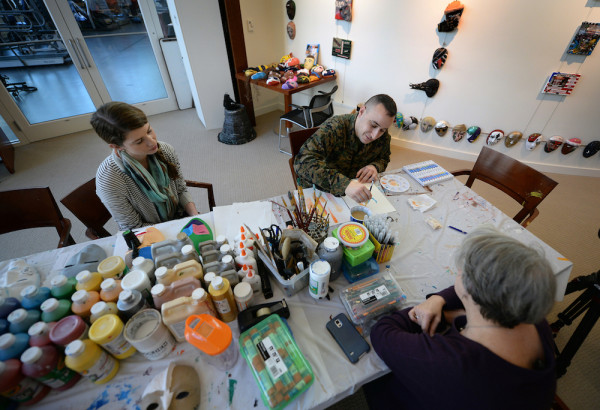

True story: A man goes to war many times. He loses buddies in battles. Carnage burns into his brain as trauma. His health, quality of life, and ability to fight diminish. Sad, no longer the effective warrior he wants to be, he contemplates suicide. And then he discovers a treatment facility supported by the National Endowment for the Arts. There, one day, he tells me: “Now that I have writing in my life, I don’t want to put a bullet in my head.”
Through that NEA-backed program, called the National Intrepid Center of Excellence at Walter Reed National Military Medical Center, I have worked with more than 1,000 service members like this man. A vet and artist myself, I teach creative writing as part of NICoE’s art-therapy program for active service members who have post-traumatic stress disorder and traumatic brain injury.

Mask by a military service member from art therapy sessions at the National Intrepid Center of Excellence, Walter Reed National Military Medical Center.National Museum of Health and Medicine photo
Currently, $2.6 million in yearly support goes to nine NEA-supported creative arts therapists at seven military treatment centers, in addition to supplies, research, and program support. That translates to more than 800 total patient encounters per month, and 500 hours a month of care coordination, program development, research, and community outreach, on average. Like the rest of the NEA — and just like the Marine Corps I served in — those therapists make a lot out of a little money.
I understand the “smaller government is better” fiscal priorities of the current administration. But the president’s proposed budget completely defunds the NEA, and that could mean the end of one the greatest treatment programs that exists for our bravest men and women.
Each week at the National Intrepid Center of Excellence, a small cohort of service members arrives for their holistic and intense four-week outpatient treatment. These patients include men and women who have survived seven, eight, even nine combat deployments. They are not well, sometimes in very invisible ways. But they love their country and want to get back in the fight, or to walk away proudly at their end of service.
As part of the clinical art therapy program, each service member designs a mask, empowering them to take traumatic, silent, unspeakable horrors they’ve witnessed and give them facial form. They’re able to craft personal mental wounds into something tangible. They’re able to control their memories instead of their memories controlling them.
In a November 2015 TED talk, NICoE art therapist Melissa Walker shared an anecdote about one patient in this course, a fairly high-ranking service member, couldn’t effectively lead, plagued by nightmares of a bloody face he’d seen. Through mask-making, he was able to recreate that face. He was able to stare it down. He was able to look through it, process that trauma, and then get better for himself and those under his charge.
Many other alternative treatments are offered to the service members — music therapy, dance therapy, therapeutic writing, creative writing (the session I help lead) — as part of the patient-centered, “what works for you?” approach. Each week, I tell the service members how writing helped me heal from my own combat stress. We do some creative writing prompts, and, well, this isn’t magic: Not every patient digs the writing part or benefits from it. But those who do can change profoundly.
Department of Defense photo

This is true, patient-centered care at a cutting edge research facility, and arts engagement is a core tenet of the treatment. Science and patient feedback have confirmed the program’s effectiveness; if it stays funded, it’s set to be replicated at 12 centers nationwide. The National Intrepid Center of Excellence clearly isn’t “veterans playing with popsicle sticks,” as a dismissive critic once told me on Twitter.
As the long war enters its 16th year, with new battles on the horizon, I can’t rationalize defunding the NEA and stripping away programs like this, which are using creativity to help our service members heal. The cost-benefit analysis of these cuts doesn’t add up. Why send men and women to war, while depriving them of a proven program that helps them work through the damage that war does to their psyches? What we can save in taxpayer dollars is nothing, next to what we owe these warriors.
Dario DiBattista is the editor of “Retire the Colors: Veterans & Civilians on Iraq & Afghanistan” He is working on a co-written screenplay about Marine’s homecoming from war. Follow him on Twitter.
